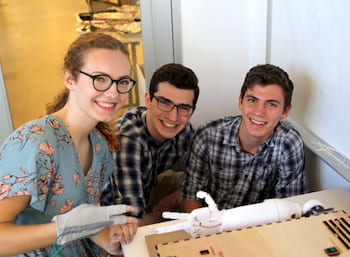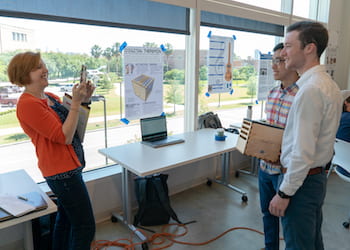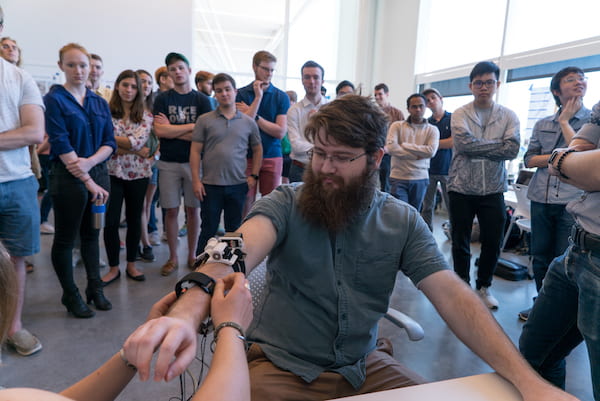NEWS RELEASE
Editor’s note: Links to video and high-resolution images for download appear at the end of this release.
David Ruth
713-348-6327
david@rice.edu
Mike Williams
713-348-6728
mikewilliams@rice.edu
Art is what you mecha-make it
Rice University students turn mechatronics lessons into interactive art at Moody Center
HOUSTON – (May 2, 2019) – Sensors and motors and microprocessors don’t mean much without the spark of an idea to bring them together into something cool. A small gallery at Rice University’s Moody Center for the Arts was full of them recently.
A classroom led by mechanical engineer Marcia O’Malley of Rice’s Brown School of Engineering took over the space so students could present their mechatronic art creations: interactive, table-top machines that used everything they had learned in the service of fun.
“Students in the class are typically juniors, seniors or graduate students and I’m really trying to bring together a lot of the fundamental topics from their majors to see how mechanical systems, electrical systems and computer controls integrate,” said O’Malley, the Stanley C. Moore Professor of Mechanical Engineering and a professor of electrical and computer engineering and computer science.

Rice University students — from left, Liz Kacpura, Noah Kenner and Caz Smith – demonstrate their Ro Sham Bot, a rock-paper-scissors robot, at an exhibition by engineering students of mechatronic art at Rice’s Moody Center for the Arts. Photo by Donald Soward
“The class culminates with this project, and this year I wanted to do the theme of interactive art,” she said. “They’re all asked to do some kind of mechatronic system that must have mechanical design, sensing and actuation or some kind of action. It might not be motion, but it might be light or sound. And it has to incorporate the control system, the algorithms that decide what to do with the sensor input and how to act.”
More than a dozen projects filled the gallery with light, music and mechanical sounds, but none as loud as the delighted chatter of students playing with each other’s completed creations for the first time.
Musical interpretations included a light-triggered guitar, a proximity-triggered ukulele and a unique theremin. A camera-enabled box read facial expressions and played music to match the user’s mood. There were several puzzles, a mechanical flower that would grow, bloom and sleep in response to its environment, and a ball-button enabled screen that let one make and pop bubbles endlessly.
“It’s very satisfying,” creator Amelia Brumwell told the crowd during her presentation.
In one corner, a mechanical hand engaged all comers in a challenging round of rock-paper-scissors.

Rice University Professor Marcia O’Malley captures Andrew Low, center, and Eric Voigt with their digital theramin at an exhibition of mechatronic art at Rice’s Moody Center for the Arts. Photo by Brandon Martin
Abbas Presswala, who took the course as a visiting graduate student from Purdue University, made the guitar with teammate Craig Broadman and said the course quickly became his favorite.
“I’ve learned a ton, and it really enforced all the principles,” he said. “The application of things and the artistic mechanisms were really different from what you get in other courses. I enjoyed it from the beginning to the end.”
“I really learned so much in this class,” said senior Rebecca Nikonowicz, the brains behind the ukulele, who plans to pursue a Ph.D. in biomedical engineering. “I want to focus on human-robot interaction and I took this class to familiarize myself with the whole idea of mechatronics.
“I feel so much more confident about sensors and motors and the idea of designing an analog vs. digital control,” she said. “To me, that’s so fun and cool and I never would have been able to wrap my brain around all that stuff if I hadn’t been able to take this course.”

Rice University student Joshua Fleck gets ready to play a mechatronic-enhanced video game at the Moody Center for the Arts. Photo by Brandon Martin
-30-
Follow Rice News and Media Relations via Twitter @RiceUNews.
Video:
Video produced by Brandon Martin/Rice University
Related materials:
Mechatronics and Haptic Interfaces Lab (O’Malley lab): https://mahilab.rice.edu
Department of Mechanical Engineering: https://mech.rice.edu
George R. Brown School of Engineering: https://engineering.rice.edu
Images for download:
https://news2.rice.edu/files/2019/05/0429_MECHA-1-WEB.jpg
Rice University students — from left, Liz Kacpura, Noah Kenner and Caz Smith – demonstrate their Ro Sham Bot, a rock-paper-scissors robot, at an exhibition by engineering students of mechatronic art at Rice’s Moody Center for the Arts. (Credit: Donald Soward/Rice University)
https://news2.rice.edu/files/2019/05/0429_MECHA-6-WEB.jpg
Rice University Professor Marcia O’Malley captures Andrew Low, center, and Eric Voigt with their digital theramin at an exhibition of mechatronic art at Rice’s Moody Center for the Arts. (Credit: Brandon Martin/Rice University)
https://news2.rice.edu/files/2019/05/0429_MECHA-8-WEB-3.jpg
Rice University student Joshua Fleck gets ready to play a mechatronic-enhanced video game at the Moody Center for the Arts. (Credit: Brandon Martin/Rice University)
Located on a 300-acre forested campus in Houston, Rice University is consistently ranked among the nation’s top 20 universities by U.S. News & World Report. Rice has highly respected schools of Architecture, Business, Continuing Studies, Engineering, Humanities, Music, Natural Sciences and Social Sciences and is home to the Baker Institute for Public Policy. With 3,962 undergraduates and 3,027 graduate students, Rice’s undergraduate student-to-faculty ratio is just under 6-to-1. Its residential college system builds close-knit communities and lifelong friendships, just one reason why Rice is ranked No. 1 for lots of race/class interaction and No. 2 for quality of life by the Princeton Review. Rice is also rated as a best value among private universities by Kiplinger’s Personal Finance.





